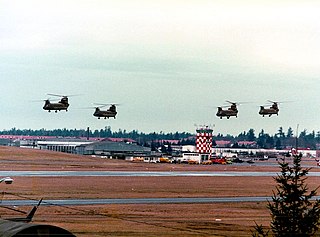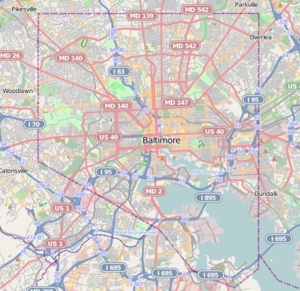
Roosevelt Field is a former airport, located in Westbury, Long Island, New York. Originally called the Hempstead Plains Aerodrome, or sometimes Hempstead Plains field or the Garden City Aerodrome, it was a training field for the Air Service, United States Army during World War I.

Martin State Airport is a joint civil-military public use airport located nine nautical miles east of the central business district of Baltimore, in Baltimore County, Maryland, United States. The facility is located within the census-designated place of Middle River on Maryland State Highway 150, near the intersection of Maryland State Highway 700. The Maryland Aviation Administration operates the airport on behalf of the Maryland Department of Transportation. MTN is a general aviation relief airport.

Old Saint Paul's Cemetery is a cemetery located in downtown Baltimore, Maryland, United States. It is noted for the several important historical figures that are interred in its grounds.

Charleston Air Force Base is a United States military facility located in the City of North Charleston, South Carolina. The facility is under the jurisdiction of the United States Air Force's 628th Air Base Wing, a subordinate element of the Air Mobility Command (AMC). It is part of Joint Base Charleston, which combined Charleston Air Force Base with Naval Support Activity Charleston.

Lincoln Airport is a joint public/military airport five miles (8.0 km) northwest of downtown Lincoln, the state capital, in Lancaster County, Nebraska, United States. It is owned by the Lincoln Airport Authority and is the second-largest airport in Nebraska. It is included in the Federal Aviation Administration (FAA) National Plan of Integrated Airport Systems for 2023–2027 in which it is categorized as a non-hub primary commercial service facility. It has four gates with jetways, to be, as of February 2022, expanded to six.

Westfield-Barnes Regional Airport is a joint civil-military airport in Hampden County, Massachusetts, three miles (6 km) north of Westfield and northwest of Springfield. It was formerly Barnes Municipal Airport; the National Plan of Integrated Airport Systems for 2011–2015 categorized it as a general aviation facility. Westfield-Barnes is one of Massachusetts' largest airports with a strong flight training, general aviation, and military presence. It is also known as Barnes Air National Guard Base.

Gray Army Airfield, also known as Gray AAF, is a military airfield located within Joint Base Lewis–McChord near Tacoma, in Pierce County, Washington, United States.

Hawkins Field is a joint civil-military public airport in Jackson, Mississippi. It is owned by the City of Jackson and operated by the Jackson Municipal Airport Authority. The National Plan of Integrated Airport Systems for 2011–2015 called it a general aviation facility.

The 175th Wing is a unit of the Maryland Air National Guard, stationed at Warfield Air National Guard Base, Middle River, Maryland. If activated to federal service, components of the Wing are gained by the two separate major commands of the United States Air Force: Air Combat Command (ACC) and United States Air Forces in Europe (USAFE).

Daniel Field is a public use airport located one nautical mile (2 km) west of the central business district of Augusta, a city in Richmond County, Georgia, United States. It is owned by the City of Augusta and operated by the General Aviation Commission. This airport is included in the National Plan of Integrated Airport Systems for 2021–2025, which categorized it as a general aviation facility.

The Maryland Air National Guard is the aerial militia of the U.S. state of Maryland, and a reserve component of the United States Air Force. It is, along with the Maryland Army National Guard, an element of the Maryland National Guard.

The 104th Fighter Squadron, nicknamed the Fightin' O's, is a unit of the Maryland Air National Guard 175th Wing stationed at Warfield Air National Guard Base, Middle River, Maryland. The 104th is equipped with the Fairchild Republic A-10C Thunderbolt II.

The 131st Fighter Squadron is a unit of the Massachusetts Air National Guard 104th Fighter Wing located at Barnes Air National Guard Base, Westfield, Massachusetts. The 131st is equipped with the F-15C/D Eagle.

Imeson Field, also known as Jacksonville Imeson Airport, was the airport serving Jacksonville, Florida, from 1927 until its closing in 1968. It was known as Jacksonville Municipal Airport prior to World War II, Jacksonville Army Airfield when the United States Army Air Forces controlled the facility during World War II, and at its closing the airport was Jacksonville – Thomas Cole Imeson Municipal Airport.

Grand Central Airport is a former airport in Glendale, California. Also known as Grand Central Air Terminal (GCAT), the airport was an important facility for the growing Los Angeles suburb of Glendale in the 1920s and a key element in the development of United States aviation. The terminal, located at 1310 Air Way, was built in 1928 and still exists, owned since 1997 by The Walt Disney Company as a part of its Grand Central Creative Campus (GC3). Three hangars also remain standing. The location of the single concrete 3,800-foot (1,200 m) runway has been preserved, but is now a public street as the runway was dug up and converted into Grand Central Avenue.

Fredrick Louis Detrick, was a U.S. Army physician, flight surgeon and pilot. He is the namesake of Fort Detrick, Maryland. Detrick, who was a teaching surgeon on the faculty of the Johns Hopkins Hospital in Baltimore, served in France during World War I, and was a member of the Maryland National Guard when he died of a heart attack in 1931.

Baltimore Municipal Airport is a former airport and United States Air Force airfield about 6 miles southeast of Baltimore, Maryland, on an artificial peninsula. Construction began in 1929 with a seaplane base and was completed in 1941. It closed on 30 December 1960. The western half of the airport was within the city of Baltimore, whereas the eastern half was in Dundalk, in Baltimore County.

Lieutenant William Dolley Tipton began his military career as a World War I Sopwith Camel pilot. The U.S. Air Force officially credits him with four aerial victories during the war, although other sources claim he had five, and thus was a flying ace. He was one of the founding officers of what would become the Maryland Air National Guard. As a member of the Maryland National Guard, he was mobilized during World War II. He rose to the rank of colonel during the war. He died on December 12, 1945, in an aircraft accident. Tipton Airport in Anne Arundel County, Maryland, is named in his honor.

Maryland's first aeronautical event was the flight of 13-year-old Edward Warren from Baltimore in Peter Carne's tethered hot air balloon in 1784.
Felts Field is an historic active airfield near Spokane, Washington, United States, on the south bank of the Spokane River.
























